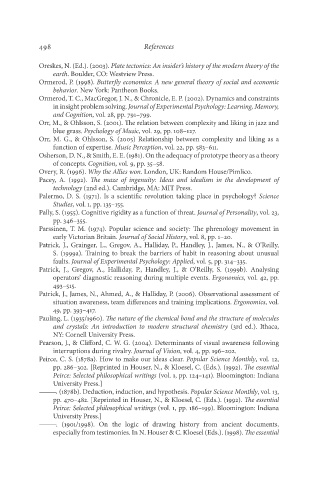Page 515 - Deep Learning
P. 515
498 References
Oreskes, N. (Ed.). (2003). Plate tectonics: An insider’s history of the modern theory of the
earth. Boulder, CO: Westview Press.
Ormerod, P. (1998). Butterfly economics: A new general theory of social and economic
behavior. New York: Pantheon Books.
Ormerod, T. C., MacGregor, J. N., & Chronicle, E. P. (2002). Dynamics and constraints
in insight problem solving. Journal of Experimental Psychology: Learning, Memory,
and Cognition, vol. 28, pp. 791–799.
Orr, M., & Ohlsson, S. (2001). The relation between complexity and liking in jazz and
blue grass. Psychology of Music, vol. 29, pp. 108–127.
Orr, M. G., & Ohlsson, S. (2005) Relationship between complexity and liking as a
function of expertise. Music Perception, vol. 22, pp. 583–611.
Osherson, D. N., & Smith, E. E. (1981). On the adequacy of prototype theory as a theory
of concepts. Cognition, vol. 9, pp. 35–58.
Overy, R. (1996). Why the Allies won. London, UK: Random House/Pimlico.
Pacey, A. (1992). The maze of ingenuity: Ideas and idealism in the development of
technology (2nd ed.). Cambridge, MA: MIT Press.
Palermo, D. S. (1971). Is a scientific revolution taking place in psychology? Science
Studies, vol. 1, pp. 135–155.
Pally, S. (1955). Cognitive rigidity as a function of threat. Journal of Personality, vol. 23,
pp. 346–355.
Parssinen, T. M. (1974). Popular science and society: The phrenology movement in
early Victorian Britain. Journal of Social History, vol. 8, pp. 1–20.
Patrick, J., Grainger, L., Gregov, A., Halliday, P., Handley, J., James, N., & O’Reilly,
S. (1999a). Training to break the barriers of habit in reasoning about unusual
faults. Journal of Experimental Psychology: Applied, vol. 5, pp. 314–335.
Patrick, J., Gregov, A., Halliday, P., Handley, J., & O’Reilly, S. (1999b). Analysing
operators’ diagnostic reasoning during multiple events. Ergonomics, vol. 42, pp.
493–515.
Patrick, J., James, N., Ahmed, A., & Halliday, P. (2006). Observational assessment of
situation awareness, team differences and training implications. Ergonomics, vol.
49, pp. 393–417.
Pauling, L. (1935/1960). The nature of the chemical bond and the structure of molecules
and crystals: An introduction to modern structural chemistry (3rd ed.). Ithaca,
NY: Cornell University Press.
Pearson, J., & Clifford, C. W. G. (2004). Determinants of visual awareness following
interruptions during rivalry. Journal of Vision, vol. 4, pp. 196–202.
Peirce, C. S. (1878a). How to make our ideas clear. Popular Science Monthly, vol. 12,
pp. 286–302. [Reprinted in Houser, N., & Kloesel, C. (Eds.). (1992). The essential
Peirce: Selected philosophical writings (vol. 1, pp. 124–141). Bloomington: Indiana
University Press.]
———. (1878b). Deduction, induction, and hypothesis. Popular Science Monthly, vol. 13,
pp. 470–482. [Reprinted in Houser, N., & Kloesel, C. (Eds.). (1992). The essential
Peirce: Selected philosophical writings (vol. 1, pp. 186–199). Bloomington: Indiana
University Press.]
———. (1901/1998). On the logic of drawing history from ancient documents,
especially from testimonies. In N. Houser & C. Kloesel (Eds.). (1998). The essential

